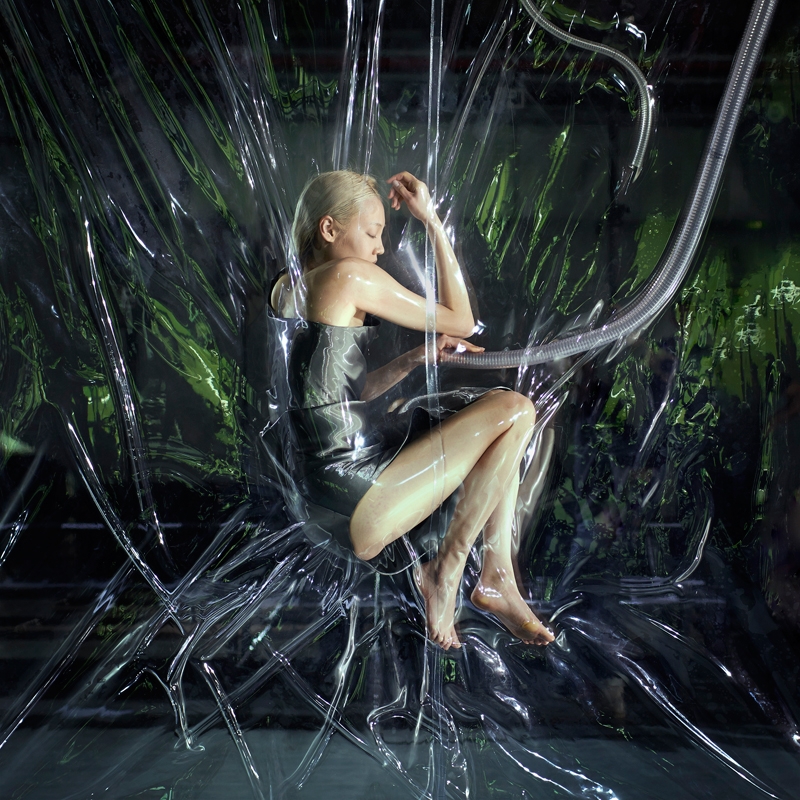The tired debate over whether or not fashion has a place in ‘the art museum’ tends to ignore the fact that ‘fashion’ is as promiscuous a term as ‘art’. Just as there is much art unlikely to be granted space in that monolith of current conceptual mores ‘the museum’, so there is fashion that seems tailormade for curatorial titillation. With her affection for extreme exoskeletal structures, curious embrace of the modern world and the latest manufacturing technology, and meticulous couture-level handwork, Amsterdam-based fashion designer Iris van Herpen’s is a natural fit; currently her work features in museum exhibitions in Calais, New York, Missouri and Miami.
Each of van Herpen’s collections is created through collaboration: variously with architects, scientists, engineers, dancers, composers and artists. Previous seasons have included acrylic garments that reproduce the furl of water cresting mid-splash across the body, jagged crystal structures jutting like giant sea urchin prickles from a dress, clouds of smoke, headpieces intended as physical evocations of synaesthesia and a leather-worked bodice of gothic complexity inspired by the facade of Chartres Cathedral. Her most recent collection was ostensibly a rare step into the world of prêt-à-porter, though with couture pieces thrown in, including dresses studded liberally with artificially produced fire-opals and a state-of-the-art flexible 3D printed dress with the texture and milky whiteness of raw squid.
Six years into her career, van Herpen’s work is far more often seen in display cabinets than on the red carpet. Despite protesting that her designs are absolutely intended to be worn, and only come alive on a moving human body, the niche of women who have both the flair and the financial wherewithal to wear van Herpen’s creations is a pretty tight one, populated, at a guess, by Daphne Guinness, Lady Gaga and Björk. Put baldly, without their inclusion in museum displays, very few people would ever have the chance to see these pieces, in all their compelling, adventurous materiality, at close range.
Next to van Herpen’s fashion collection, Shrink became a statement on physical perfection as a commodity, and homogeneous off-the-peg beauty
The flipside of the question of fashion’s place in ‘the museum’ is whether art has a place on the catwalk. This last season, van Herpen’s designs risked being upstaged by the ‘set’ – a version of Lawrence Malstaf’s artwork Shrink (1995) in which three models were suspended vacuum-wrapped between layers of plastic in the centre of the runway, fed air through umbilically-corded tubes. Populated by ‘perfect’ bodies – including the Belgian supermodel Hannelore Knuts – and watched by the editors of the world’s most powerful fashion magazines, the context of the runway had a definite impact on Shrink. Next to van Herpen’s ‘Bio Piracy’ collection, Shrink became a statement on physical perfection as a commodity, and homogeneous off-the-peg beauty.
Shrink has been widely exhibited since 1995 (including, recently, at Eyebeam in New York and as part of the File festival in São Paulo), but Malstaf intended it initially as an experiential installation, an invitation to test how easily humans can adapt to a new environment. While rather taken aback by the casual lack of attribution that has dogged images of the installation since the show, Malstaf’s respect for van Herpen as a creative force has made him philosophical about how the work has been skewed by its context. “If I had a perfectly clear message to say to the audience, why make an elaborate installation? I think it’s interesting that the work can evolve.”
A few years back, van Herpen’s beautiful, alien creations seemed far removed from any kind of commodifiable application and her investigations into physics and emerging technologies motivated more by creative indulgence than commerce. “In my work the process and the developing stage of a collection are as important as the end result. Maybe in this stage it becomes even more important to me,” she admits. “I want to enrich myself and bring my work into an non-safety-zone every time I create.” As wearable tech and intelligent garments suddenly become the stuff of the present, however, van Herpen’s engagement with science and engineering seems startlingly relevant and to offer a future in which Google Glass might make one look numinous rather than slappable.
This article was first published in the May 2014 issue.
